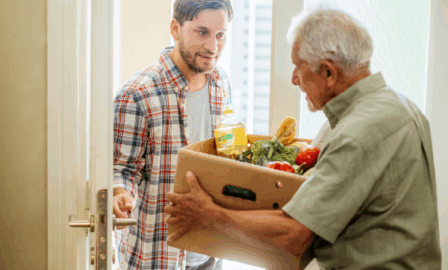How Retailers are Responding to Changes in Grocery Shopper Habits
With lingering economic effects from the COVID-19 pandemic, persisting issues with supply chain coordination, climate change, and the ongoing war in Ukraine, stress has been placed on many grocery retailers to react and adapt. Currently, there is scarcity across the entire food retail industry, with shortages in meat, poultry, dairy, eggs, bottled drinks, canned goods, and toiletry. Additionally, industries are still experiencing labor and personnel shortages that are also contributing to stress on the supply chain. Due to the pandemic, unfavorable conditions led workers to quit their jobs at near-record levels in search of superior opportunities elsewhere. Without an adequate labor supply and raw goods shortages, the supply chain is disrupted, and grocery stores aren’t receiving the inventory they need. The United States Department of Agriculture (USDA) predicts food prices to rise a total of 5% to 6% in 2022. Mass uncertainty plagues the entire food retail industry, and this has shifted grocery shopper habits.
Changes in Grocery Shopper Habits
COVID-19
The lingering effects of the COVID-19 Omicron variant and rising inflation has led to many shoppers still staying at home. People are still worried about health and safety, causing a rift between physical retailers and shoppers. This has resulted in many shoppers buying larger quantities of food, to avoid multiple shopping trips and shifting to online ordering for pick-up and delivery to avoid the stores altogether.
Supply Chain Issues
Over concerns about lack of inventory, we have seen shoppers panic buying goods to stockpile and prepare for future shortages. During the COVID-19 pandemic goods bought were long-lasting food or perceived “survival products,” such as toilet paper, canned food, pasta, rice, and frozen products. Cleaning and hygiene products were also in remarkably high demand. After the pandemic, these trends have continued, as the lingering effects of COVID-19 alongside inflation and labor shortages have led to shoppers still preparing for a prolonged shortage.
Looking for Alternatives
Many shoppers have also adapted to inflation and shortages by planning (no more “on the fly” shopping), looking for deals more frequently, avoiding meat and other non-necessity items, shopping at multiple stores, and purchasing generic brands as opposed to common brands. Strain on shopper pockets has led to them having to be creative with the way they shop and buy their groceries. Shoppers are increasingly buying from multiple retailers. In an Ipsos survey of 1,000 shoppers released in early December, 45% reported buying items from a store other than their primary grocer at least once a month thanks to supply strains.
Inflation
Due to inflation and supply issues, sales at bulk retailers Costco, Sam’s Club and BJ’s Wholesale Club rose 26.6% in dollars and 18% in volume during the fourth quarter of 2021 compared with the same quarter of 2019. Costco’s Kirkland Signature brand amassed around 58 billion dollars in sales last year, outpacing big companies such as Hershey’s, Kellog’s and Cambell’s Soup. As prices rise due to limited supply, and inflation, shoppers get more bang for their buck by buying in bulk, and products are cheaper per unit.
Recently, Clarkston published our perspective on how food companies can prepare and respond to these global food shortages; here, we’ll discuss how retailers can also respond to the changing grocery shopper habits.
Ways for Retailers to Respond
Investment in Digital Capabilities
Apprehension towards COVID and encountering others at brick-and-mortar stores led to an influx of online grocery shopping. The eCommerce market continues to expand rapidly. In 2021, the online grocery market totaled $97.7 billion in sales via pickup, delivery, and ship-to-home channels, as more than 70% of U.S. households, or 93 million, received one or more orders during the year.
Grocery retailers have also worked closely with many app developers to tailor their eCommerce presence and improve the shopping experience. From real-time tracking to automated order management, these apps focus on creating user-friendly solutions with many features. Walmart recently completed the acquisition of two FinTech businesses to help customers and members transact groceries seamlessly, and digitally.
Additionally, retailers are investing in their in-store technologies to build their digital capabilities. For example, cloud-based offer arbitration systems can integrate with stores’ Point of Sale (POS) systems and online shopping to apply coupons when applicable for orders and create seamless experience in-store and online. Pricing and inventory management technologies can enable automated price changes and stock replenishment, respectively, to help react quickly to changing product availability. Digital shelf tags and signage are other examples of technologies driving efficiency in the store and allowing store associates to focus on more value-add activities.
New Service Concepts
To respond to changing grocery shopper habits, many grocery retailers have implemented in-store dining options, rotating seasonal café menus, chef-prepared meals, grab-and-go options, and expanded beer and wine selections, to enjoy in-store or at home. Experts estimate grocery retailers can increase general sales by 20% to 25% simply by having a restaurant or extra prepared food options available in their brick-and-mortar locations.
Store within store concepts have also been on the rise. Major retailer Kroger recently implemented “virtual dining halls” where shoppers can order food online, bundle options, and pick up their meal to take home at the physical location. Kroger and Walmart have also created “ghost kitchens” within some of their stores, which serve as local takeout restaurants. Kroger recently invested heavily in “Kitchen United” which is a ghost kitchen operator plans to expand from 15 locations to over 500 locations over the next five years. Their focus is to sell and fulfill online food orders for delivery using third-party apps like UberEats and DoorDash. Using ghost kitchens and working with a third-party delivery service has been found to raise restaurant sales volume by 10 to 20%. Lowe’s foods also recently released a “food hall” concept for some of their stores which would make the physical location more of a dining hall than conventional grocery spot.
Adapting to Inflation
Many grocery retailers are responding to inflation by putting more private labels on their shelves. NielsenIQ data show supermarket store brands surged across all outlets. Private label sales increased by $8.5 billion to a record $27.3 billion (13.2%), while units were up 7.1% in 2021. Stores are also driving shopper attention to sales by designing web pages and apps that are optimized for digital shopping. For example, making the highest-selling (and ideally highest-margin) products easy to find helps to make the customer journey outside the store more seamless. These apps also highlight sales, and deals that may strike shoppers’ attention.
Going Forward
Grocery retailers have been experiencing the effects that inflation and supply shortages are having on their shoppers for quite some time now. These effects are naturally driving a change in shopper behavior, which retailers can stay ahead of by investing in digital capabilities, introducing new service concepts, and implementing sales tactics to help reduce the impacts of inflation. It’s critical that grocery retailers plan for these impacts now in order to stay ahead of their competition.
To better understand these trends and the impact they may have on your business, reach out to Clarkston’s grocery retail experts.
Subscribe to Clarkston's Insights
Contributions by Vishnu Avva




